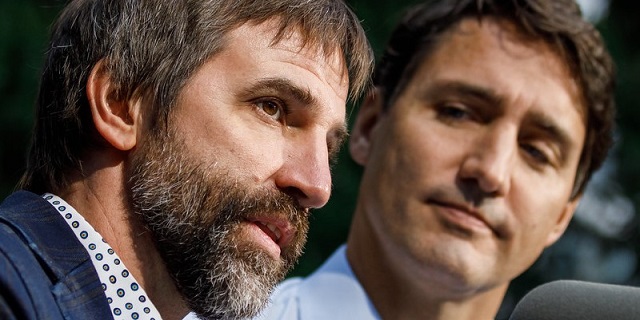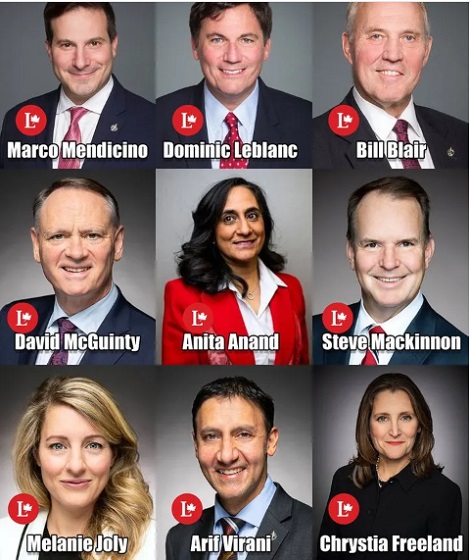Economy
Fixing the Trudeau – Guilbeault Policy Mess May Take Longer Than We’d Like – Here’s Why

From EnergyNow.ca
By Jim Warren
By spring 2024 it was pretty clear the Liberal government was headed for palliative care. A Leger poll on May 25 and an Abacus poll June 10 showed the Conservatives with a 20 point lead over the Liberals.
As the likelihood of their imminent defeat increased, the Trudeau Liberals stepped up the implementation of legislation and regulations inimical to the gas and petroleum industries. Their efforts in 2024 included legislation limiting freedom of speech for companies and individuals who publicize environmental progress in the oil and gas sector (aka Bill C-59). The speech-muzzling measure became law on June 21.
Around the same time, Environment and Climate Change Minister, Steven Guilbeault was busy shepherding two particularly ominous regulatory packages through to finalization. One set of regulations supported Canada’s Clean Electricity Regulations—intended to eliminate the use of coal and natural gas in the production of electricity with staged decommissioning deadlines between 2035 and 2050. The second package finalized the rules for the natural gas and oil industries emissions cap intended to restrict production and growth in those industries, to take effect in 2026.
The regulations weren’t finalized until the month before the House shut down for the holidays, just weeks before Justin Trudeau’s political career was put on life support.
The green policy stampede extended to the international stage. Never mind deficits and debt, the Liberals found plenty of cash to enhance their status as world class environmental luminaries.
At November’s COP29* conference at Baku, Azerbaijan, Guilbeault and Canada’s Ambassador for Climate Change (who knew we had one?), Catherine Stewart signed us on to 15 pledges to take action on fighting climate change. Around half of the promises were merely motherhood and apple pie statements, concessions to the environmentally woke who attend these sorts of international conferences.
But several of the commitments made on our behalf came with price tags. I’m still unclear on exactly which line item in a federal budget, legislative authority or policy statement authorized the spending.
Canada’s COP29 delegation launched the $2 billion GAIA project. Apparently we are cost sharing the project with Mitsubishi. The official government report on the conference doesn’t indicate how much of the $2 billion Canada is kicking in.
Canada also showcased its green bona fides by contributing to the effort to finance the green transition and climate change adaptation in poor countries—a task expected to require developed countries to collectively spend $110 billion to $300 billion per year by 2035. Our delegation announced Canada would lead by example, making a $1billion donation to the effort.
Guilbeault and Stewart gave $10 million to Conservation International’s “Limpopo Transfrontier Conservation Area” project. They “invested” another $2.5 million in the World Wildlife Fund’s “Building Resilient Communities through Marine Conservation in Madagascar” project.
Guilbeault may indeed be angling for that UN job I mentioned in my last EnergyNow column. Read it Here Canada made a $1.25 million payment directly to the office of UN Secretary General, António Guterres. The donation is supposed to assist Guterres in his efforts to encourage countries to get their “Nationally Determined Contributions” handed in on time.
In a podcast conversation with Jordan Peterson several months ago, Danielle Smith noted the accelerated pace of the Liberal government’s announcement and implementation of new environmental policies detrimental to Alberta’s oil and gas sectors and the economies of both Alberta and Canada.
Smith said one of the effects of enacting so many new environmental measures would be to make it extremely difficult for the next government to reverse them all in its first term. This probably was one of the reasons behind the rush to get so much done this past year.
Peterson added a psychological dimension to the discussion. He suggested Guilbeault and Trudeau were behaving like wounded narcissists. They were acting like egomaniacs who recognized their time in office was coming to an end and wanted to do as much as possible in the time they had left to pad their reputations as “do or die” climate warriors. They were striving to guarantee their legacies as planet-saving heroes.
They are probably both right. But Smith’s assessment speaks more directly to the practical challenges a new Conservative government will confront while trying to unwind the morass of legislation and regulations needlessly hampering the growth of environmentally responsible resource development in the west. It is an effort by the outgoing government to make their anti-oil legacy tamper proof.
Simply wading through the legislative quagmire and assessing where reform is most urgent and readily achievable will take time and effort. The wheels of parliament can turn slowly. No doubt some of the bureaucrats employed by the Liberals are true believers—frightened of the “impending climate apocalypse” and unlikely to expedite changes to environmental legislation and regulations. And, there could be multi-year contracts with consultants and other suppliers and long-term funding arrangements with companies and NGOs that will be difficult to unwind.
Let’s not forget the inevitable legal challenges that will threaten to hold up the reform process. Environmental groups and other special interests can be expected to use the courts to block efforts to reverse Liberal government policy. Ideally, the new government will cut off funding support for anti-oil environmental groups. Then at least supporters of the gas and petroleum sectors won’t be sued by activists funded with our tax dollars.
Then there are all the other important things governments are required to do and a limited amount of time to do them—drafting fiscally responsible budgets and dealing with the possibility of US tariffs on our exports come to mind as things near the top of the to-do list.
The highly anticipated Poilievre government may not be able to move as far and fast in reversing the Trudeau-Guilbeault legacy as we might like. They will face immense challenges and should be given a fair bit of slack if they can’t fix everything early in their first term.
*COP stands for Conference of the Parties to the United Nations Framework Convention on Climate Change (UNFCCC). The framework was adopted by the countries attending the UN sponsored Rio Earth Summit held at Rio de Janeiro, Brazil in 1992. The number in COP29 indicates it is the 29th annual post-Rio conference of the parties.
Business
It Took Trump To Get Canada Serious About Free Trade With Itself

From the Frontier Centre for Public Policy
By Lee Harding
Trump’s protectionism has jolted Canada into finally beginning to tear down interprovincial trade barriers
The threat of Donald Trump’s tariffs and the potential collapse of North American free trade have prompted Canada to look inward. With international trade under pressure, the country is—at last—taking meaningful steps to improve trade within its borders.
Canada’s Constitution gives provinces control over many key economic levers. While Ottawa manages international trade, the provinces regulate licensing, certification and procurement rules. These fragmented regulations have long acted as internal trade barriers, forcing companies and professionals to navigate duplicate approval processes when operating across provincial lines.
These restrictions increase costs, delay projects and limit job opportunities for businesses and workers. For consumers, they mean higher prices and fewer choices. Economists estimate that these barriers hold back up to $200 billion of Canada’s economy annually, roughly eight per cent of the country’s GDP.
Ironically, it wasn’t until after Canada signed the North American Free Trade Agreement that it began to address domestic trade restrictions. In 1994, the first ministers signed the Agreement on Internal Trade (AIT), committing to equal treatment of bidders on provincial and municipal contracts. Subsequent regional agreements, such as Alberta and British Columbia’s Trade, Investment and Labour Mobility Agreement in 2007, and the New West Partnership that followed, expanded cooperation to include broader credential recognition and enforceable dispute resolution.
In 2017, the Canadian Free Trade Agreement (CFTA) replaced the AIT to streamline trade among provinces and territories. While more ambitious in scope, the CFTA’s effectiveness has been limited by a patchwork of exemptions and slow implementation.
Now, however, Trump’s protectionism has reignited momentum to fix the problem. In recent months, provincial and territorial labour market ministers met with their federal counterpart to strengthen the CFTA. Their goal: to remove longstanding barriers and unlock the full potential of Canada’s internal market.
According to a March 5 CFTA press release, five governments have agreed to eliminate 40 exemptions they previously claimed for themselves. A June 1 deadline has been set to produce an action plan for nationwide mutual recognition of professional credentials. Ministers are also working on the mutual recognition of consumer goods, excluding food, so that if a product is approved for sale in one province, it can be sold anywhere in Canada without added red tape.
Ontario Premier Doug Ford has signalled that his province won’t wait for consensus. Ontario is dropping all its CFTA exemptions, allowing medical professionals to begin practising while awaiting registration with provincial regulators.
Ontario has partnered with Nova Scotia and New Brunswick to implement mutual recognition of goods, services and registered workers. These provinces have also enabled direct-to-consumer alcohol sales, letting individuals purchase alcohol directly from producers for personal consumption.
A joint CFTA statement says other provinces intend to follow suit, except Prince Edward Island and Newfoundland and Labrador.
These developments are long overdue. Confederation happened more than 150 years ago, and prohibition ended more than a century ago, yet Canadians still face barriers when trying to buy a bottle of wine from another province or find work across a provincial line.
Perhaps now, Canada will finally become the economic union it was always meant to be. Few would thank Donald Trump, but without his tariffs, this renewed urgency to break down internal trade barriers might never have emerged.
Lee Harding is a research fellow with the Frontier Centre for Public Policy.
Alberta
Low oil prices could have big consequences for Alberta’s finances

From the Fraser Institute
By Tegan Hill
Amid the tariff war, the price of West Texas Intermediate oil—a common benchmark—recently dropped below US$60 per barrel. Given every $1 drop in oil prices is an estimated $750 million hit to provincial revenues, if oil prices remain low for long, there could be big implications for Alberta’s budget.
The Smith government already projects a $5.2 billion budget deficit in 2025/26 with continued deficits over the following two years. This year’s deficit is based on oil prices averaging US$68.00 per barrel. While the budget does include a $4 billion “contingency” for unforeseen events, given the economic and fiscal impact of Trump’s tariffs, it could quickly be eaten up.
Budget deficits come with costs for Albertans, who will already pay a projected $600 each in provincial government debt interest in 2025/26. That’s money that could have gone towards health care and education, or even tax relief.
Unfortunately, this is all part of the resource revenue rollercoaster that’s are all too familiar to Albertans.
Resource revenue (including oil and gas royalties) is inherently volatile. In the last 10 years alone, it has been as high as $25.2 billion in 2022/23 and as low as $2.8 billion in 2015/16. The provincial government typically enjoys budget surpluses—and increases government spending—when oil prices and resource revenue is relatively high, but is thrown into deficits when resource revenues inevitably fall.
Fortunately, the Smith government can mitigate this volatility.
The key is limiting the level of resource revenue included in the budget to a set stable amount. Any resource revenue above that stable amount is automatically saved in a rainy-day fund to be withdrawn to maintain that stable amount in the budget during years of relatively low resource revenue. The logic is simple: save during the good times so you can weather the storm during bad times.
Indeed, if the Smith government had created a rainy-day account in 2023, for example, it could have already built up a sizeable fund to help stabilize the budget when resource revenue declines. While the Smith government has deposited some money in the Heritage Fund in recent years, it has not created a dedicated rainy-day account or introduced a similar mechanism to help stabilize provincial finances.
Limiting the amount of resource revenue in the budget, particularly during times of relatively high resource revenue, also tempers demand for higher spending, which is only fiscally sustainable with permanently high resource revenues. In other words, if the government creates a rainy-day account, spending would become more closely align with stable ongoing levels of revenue.
And it’s not too late. To end the boom-bust cycle and finally help stabilize provincial finances, the Smith government should create a rainy-day account.
-

 2025 Federal Election2 days ago
2025 Federal Election2 days agoPolls say Canadians will give Trump what he wants, a Carney victory.
-

 2025 Federal Election2 days ago
2025 Federal Election2 days agoThe Anhui Convergence: Chinese United Front Network Surfaces in Australian and Canadian Elections
-

 2025 Federal Election1 day ago
2025 Federal Election1 day agoPoilievre Campaigning To Build A Canadian Economic Fortress
-

 Automotive1 day ago
Automotive1 day agoCanadians’ Interest in Buying an EV Falls for Third Year in a Row
-

 2025 Federal Election2 days ago
2025 Federal Election2 days agoTrump Has Driven Canadians Crazy. This Is How Crazy.
-

 2025 Federal Election2 days ago
2025 Federal Election2 days agoCarney Liberals pledge to follow ‘gender-based goals analysis’ in all government policy
-

 2025 Federal Election2 days ago
2025 Federal Election2 days agoPoilievre’s Conservatives promise to repeal policy allowing male criminals in female jails
-

 conflict2 days ago
conflict2 days agoTrump tells Zelensky: Accept peace or risk ‘losing the whole country’






